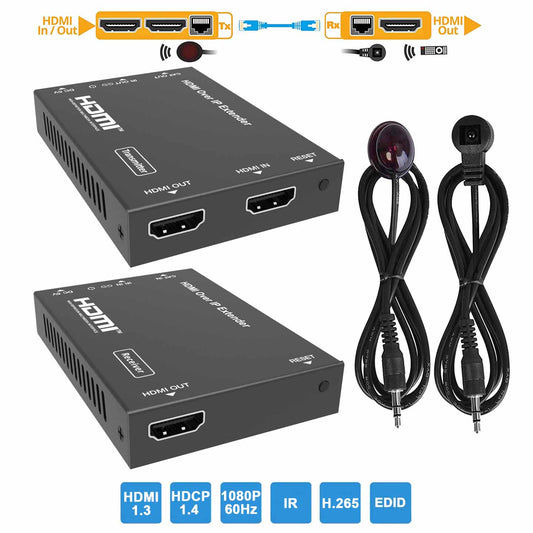Collection: HDMI over IP Extenders
HDMI over IP extenders are devices that enable the transmission of HDMI video and audio signals over an IP network. They allow users to distribute high-definition audio and video content from a source device (such as a computer, Blu-ray player, or set-top box) to multiple display devices located in different areas.
The basic setup of an HDMI over IP extender system involves an encoder and a decoder. The encoder is connected to the HDMI source device, and it compresses and converts the HDMI signals into IP packets. These IP packets are then transmitted over an Ethernet network. The decoder is connected to the destination display device and receives and decodes the IP packets back into HDMI signals, which are then displayed on the screen.
HDMI over IP extenders offer several advantages. They provide flexibility in terms of distributing video and audio signals over long distances without the limitations of physical cables. They can transmit signals over standard network infrastructure, including CAT5/6/7 Ethernet cables or even existing IP networks. This makes them suitable for applications where the source and display devices are located far apart or in separate rooms/buildings. Another benefit is scalability. With HDMI over IP extenders, it's possible to transmit the HDMI signals to multiple displays simultaneously by utilizing multicast or unicast transmission methods. This makes them suitable for applications like digital signage, conference rooms, classrooms, and entertainment venues where the same content needs to be displayed on multiple screens.
The basic setup of an HDMI over IP extender system involves an encoder and a decoder. The encoder is connected to the HDMI source device, and it compresses and converts the HDMI signals into IP packets. These IP packets are then transmitted over an Ethernet network. The decoder is connected to the destination display device and receives and decodes the IP packets back into HDMI signals, which are then displayed on the screen.
HDMI over IP extenders offer several advantages. They provide flexibility in terms of distributing video and audio signals over long distances without the limitations of physical cables. They can transmit signals over standard network infrastructure, including CAT5/6/7 Ethernet cables or even existing IP networks. This makes them suitable for applications where the source and display devices are located far apart or in separate rooms/buildings. Another benefit is scalability. With HDMI over IP extenders, it's possible to transmit the HDMI signals to multiple displays simultaneously by utilizing multicast or unicast transmission methods. This makes them suitable for applications like digital signage, conference rooms, classrooms, and entertainment venues where the same content needs to be displayed on multiple screens.
-
HDMI KVM Extender over IP Ethernet Cat5e/6 Cable 1080P 60Hz 150m-BUNGPUNG
Vendor:BUNGPUNGRegular price $170.09 USDRegular priceUnit price / per$135.90 USDSale price $170.09 USD -
HDMI Extender over IP Ethernet CAT5e/6 Cable 1080P 60Hz 150m-BUNGPUNG
Vendor:BUNGPUNGRegular price $144.44 USDRegular priceUnit price / per$135.90 USDSale price $144.44 USD


